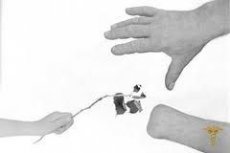Medical expert of the article
New publications
Phantom pains in the arms and legs
Last reviewed: 04.07.2025

All iLive content is medically reviewed or fact checked to ensure as much factual accuracy as possible.
We have strict sourcing guidelines and only link to reputable media sites, academic research institutions and, whenever possible, medically peer reviewed studies. Note that the numbers in parentheses ([1], [2], etc.) are clickable links to these studies.
If you feel that any of our content is inaccurate, out-of-date, or otherwise questionable, please select it and press Ctrl + Enter.

When can phantom pain occur?
Not necessarily after surgery. It can happen even years after surgery.
Phantom pain can bother a patient either in one limb or in several parts of the body. The sensation of a non-existent limb is so real that patients feel their hand clenching into a fist or unclenching, and their leg can rise or fall. At the same time, the limbs hurt a lot. But these parts of the body no longer exist.
Pain in non-existent limbs can be accompanied by pain in other parts of the body, quite real ones. They can intensify even from a simple touch.
This happens because nerve endings transmit pain impulses throughout the body.
These pains can be aggravated by stress, sudden movements, and an uncomfortable position. Even strong medical treatments such as fast-acting drugs or surgery may not change anything. The pains rarely subside.
How does phantom pain manifest itself?
Most often, this is pain after surgical interventions. For example, after a person has an arm or a leg removed. The point is that a person feels pain in the removed limb as if he felt it in a real, actual part of the body. But in fact, this limb does not exist, it is a phantom. Hence the name - phantom pain.
A person who feels phantom pain even feels the size of his non-existent leg or arm. The arm or leg seems so real to the person that he even tries to use it - to take something or try to play with a ball.
Strong and weak pains
They are different, with different degrees of power. Pains can be frequent or rare. The frequency of pain can reach up to 2-3 times in 6-7 days.
Phantom pain is divided into three degrees
- The first is a strong and burning pain.
- The second is pain similar to electric shocks, it is called neuralgic.
- The third is like a vice, when a person’s muscles cramp
Characteristics of phantom pain
They can continue even after the injured tissues and bones have healed and can last for years.
Often phantom pains are similar to those that were present before the operation. For example, a patient whose arm was amputated may complain of pain in the fingers that bothered him before the operation. Moreover, such cases are observed in almost half of the operated patients. And for quite a long time - at least two years.
Pain zones can be observed either on the same side as before surgery, or on the opposite side.
Moreover, even a light touch to a healthy part of the body can provoke a severe attack of pain in the head or limb.
Chronic diseases can also provoke pain in the operated arms or legs. For example, heart diseases that bother a person for many years after the operation can provoke painful sensations in the phantom limb even ten years after it was removed.
Blockades with painkillers can relieve such pain. However, not for long: just for a few hours or days.
Vibrators placed on the damaged area of the arm or leg, as well as electrical impulses, can help (temporarily).
 [ 6 ], [ 7 ], [ 8 ], [ 9 ], [ 10 ], [ 11 ], [ 12 ], [ 13 ], [ 14 ]
[ 6 ], [ 7 ], [ 8 ], [ 9 ], [ 10 ], [ 11 ], [ 12 ], [ 13 ], [ 14 ]
Phantom pain patients are not alone
This percentage is quite large in the world. 75% of patients with phantom pains try to cure them, often only temporarily. Only 15% of people experience pains that subside within 5-7 years. The rest experience them.

